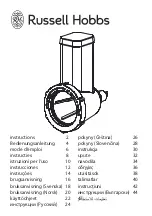
13
zone, providing the chamber door is closed. The chamber’s low pressure sucks the air out of the
roasting chamber via the air transfer tube and the bean chute, providing its door is closed. There are
gaps between the drum and both endplates of the roaster. The drum’s low pressure creates suction at
both ends, which draws air into the drum through these gaps from the heated space between the drum
and the outer shell. Make-up air enters via a hole at the lower back of the roasting chamber, near the
electronics cooling fan.
In the M3s and the M6, the same fan, air tube, and bean chute create suction in the drum. From this
point on, the flow is different. There is no air hole at the back of the roaster. There are two ~3mm
longitudinal slots underneath the roaster below the heaters, running the drum’s entire length. Air enters
via these shots where it is heated. The majority of the heated air moves back and enters the drum via a
perforated backplate. Some air still enters the drum via the space between the front of the drum and the
front plate.
There are also Quests, probably all M3s models, with three or four air inlet tubes. The tubes enter the
chamber from the roaster’s backplate, one between each of the heater’s legs and one at the top. If
there’s a fourth one, it’s at the top left, as viewed from the front. We believe all these versions have
insulated roasting chambers.
Electronics:
The heater control and the blower control are kluge-wired using discrete components. The
two are virtually identical, using circuitry similar to that of light dimmers. The controls are variable
resistors, which control Triacs. The circuitry chops the AC sine wave, delivering pulses of varying
width to the blower motor and the heaters. The Triac for the heaters is on the chassis for conductive
cooling. In newer roasters, with somewhat bigger heaters, a small heat sink is also fitted on the heater
Triac. The Triac for the blower motor is identical, but it is merely air-cooled since the current through it
is relatively small. A 5-Watt muffin fan located on the bottom of the cabinet helps to keep the Triacs
cool.
The following schematic is from an Mk-2. There are likely component value differences between
roasters based on production date. The controls on all the Quest roasters are about the same. The two
control circuits are similar to those in light dimmers. The resistor across the blower speed control stops
the blower from being switched off in some models. The heaters are in parallel, so if one fails, the
roaster will run at half power. The heaters on the 220-volt version are identical to the 110-volt version
but are in series. If one heater fails, then the roaster will not heat at all.










































